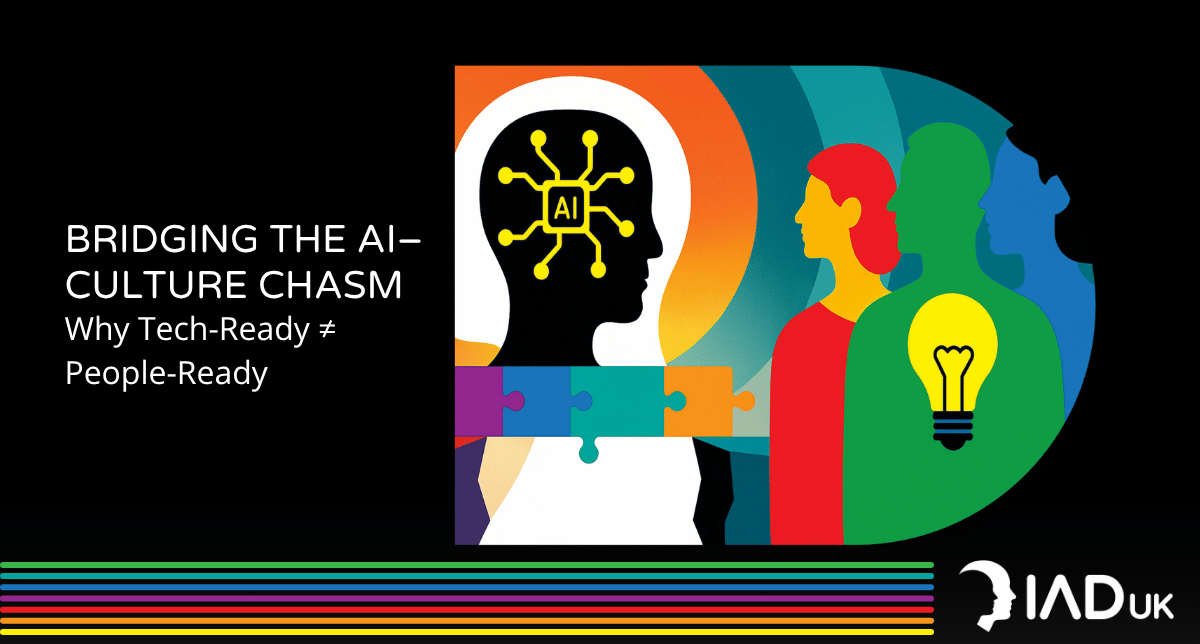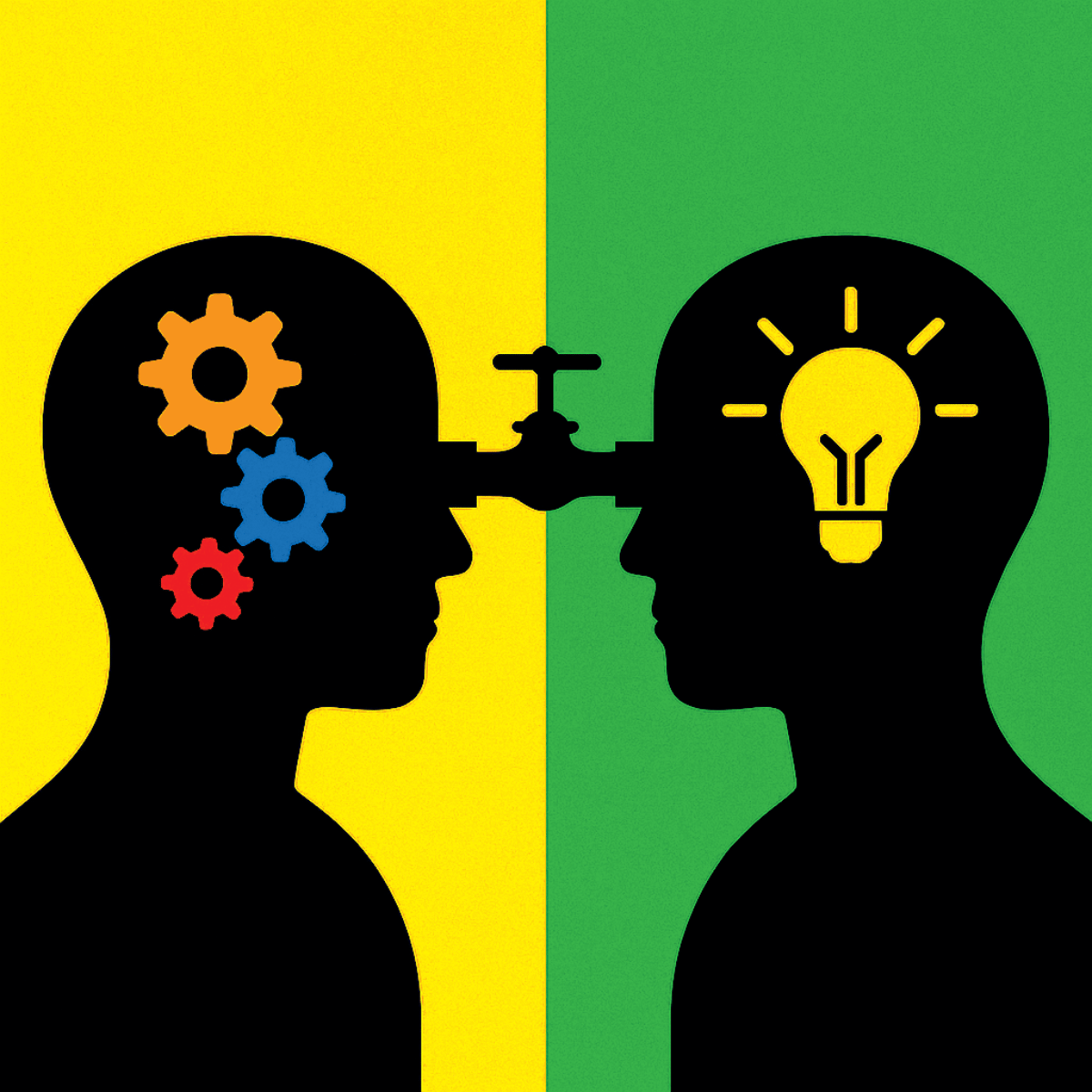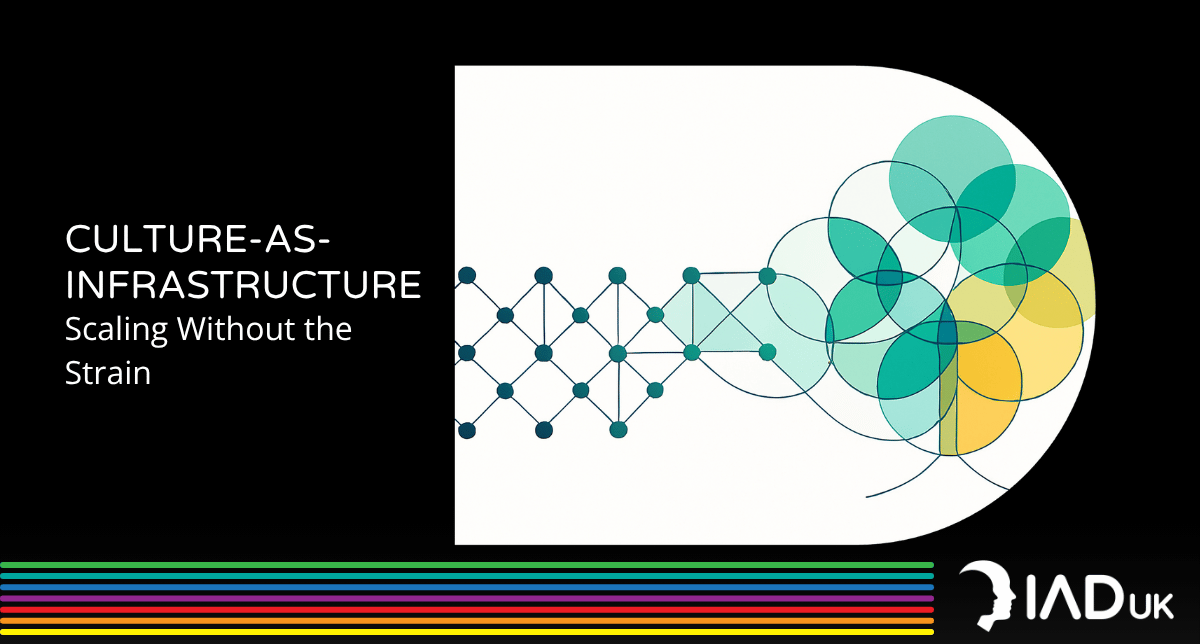Bridging the AI–Culture Chasm: Why Tech-Ready ≠ People-Ready

Artificial intelligence is being adopted at speed across mid-market organisations. Boards are eager. CTOs are funded. Pilots are underway. Yet beneath this momentum lies a growing discomfort among organisational development leaders: the culture is not keeping pace.
The headlines speak of transformation, but the lived experience tells another story. Too often, leaders are left struggling to translate technical potential into coherent human systems. According to McKinsey’s 2025 report1, the greatest barrier to successful AI implementation is no longer technical readiness. It is leadership capability.
Meanwhile, Node4’s Mid-Market Report (2025)2 reveals a deeper challenge. Business and IT leaders are not just misaligned. They are operating on different maps. Strategic intent is being lost in translation. Infrastructure evolves, but shared understanding stalls.
This gap is more than a miscommunication. It is a cultural chasm. And unless addressed, it risks turning AI from a lever of growth into a source of organisational drag.
Misdiagnosing Readiness: Infrastructure vs Intellect
Many organisations consider themselves AI-ready because their systems are integrated, their data pipelines clean, and their vendors selected. Yet these criteria overlook the critical dimension: whether their leaders are ready to think differently.

Technical infrastructure is necessary. But without the cognitive infrastructure to match, AI becomes a foreign object in the system. Leaders default to old habits dressed in new tools. Strategic decisions become increasingly reactive. Ethical reflection is replaced by procedural compliance.
Node4’s findings expose the heart of the issue. IT and business leaders are not just disconnected in priorities. They are applying different definitions of readiness. One side optimises for architecture, the other for outcomes. Neither is equipped to mediate the gap.
This is not a skills issue. It is a meaning-making issue. The real readiness problem is intellectual. It sits in how leaders frame uncertainty, interpret complexity, and construct coherence in unfamiliar territory. Without that capacity, AI will be adopted, but not absorbed
The Leadership Gap is Cognitive, Not Just Technical
Leadership capability is often equated with experience, charisma, or domain expertise. But in the context of AI adoption, these are not enough. What is required is cognitive range.
McKinsey’s research highlights a growing awareness: the real constraint on AI effectiveness is not in data quality or deployment speed, but in the capacity of leaders to make sense of unfamiliar, fast-evolving systems. When the pace of change exceeds the pace of understanding, decision-making falters.
Dynamic Intelligence addresses this directly. It develops a leader’s ability to shift perspective, integrate competing priorities, and hold ambiguity without defaulting to binary thinking. These are not personality traits. They are cognitive capabilities that can be measured and developed.
In the absence of this development, leadership responses to AI tend to become brittle. Some over-assert control. Others abdicate to technical experts. Both approaches bypass the deeper work of aligning innovation with meaning. The result is often surface-level progress that lacks strategic depth and ethical robustness.
Dynamic Intelligence does not replace leadership. It upgrades it.

The Culture Lag: When Meaning-Making Can't Keep Up
AI does not just change what organisations do. It changes how they need to think.

Yet in many workplaces, the assumptions, language, and norms that shape meaning-making remain rooted in an earlier era. Leaders introduce advanced systems into environments still operating with legacy mental models. This is not resistance. It is a structural mismatch.
Culture, at its core, is a shared interpretation of what matters. When that interpretation lags behind technological change, people fill the void with caution, speculation, or performative agreement. They comply without understanding. They contribute without alignment.
This misalignment slows down critical decisions. It creates friction between functions. It erodes the conditions necessary for trust, innovation, and ethical discernment.
Dynamic Intelligence provides a way through. It equips people to reconstruct meaning in real time, enabling culture to evolve in step with complexity. Without this capacity, even the most sophisticated systems will stall inside organisations that cannot metabolise their implications.
Why Dynamic Intelligence Is Now a Strategic Necessity
As AI systems grow more capable, the cognitive demands on human leaders increase. Not in terms of speed or volume, but in the capacity to interpret, integrate, and navigate complexity with discernment.
Case Insight: Reducing Decision-Latency with DIDS
Consider a mid-sized organisation beginning to scale its use of generative AI. The technology rollout is sound. Infrastructure is stable. But decisions are slow, communication is strained, and confidence in the programme is eroding.
A Leadership Friction Diagnostic could expose what sits beneath the surface: not a lack of will, but a lack of shared framing. IT leaders might be operating from a problem-solving orientation focused on efficiency and technical accuracy. Business leaders might be approaching the same decisions through a commercial lens, prioritising speed and value realisation. Neither group is wrong. But their underlying thinking styles and priorities are misaligned.
When friction at this level is left unexamined, it narrows the space for dialogue. Perspective-taking becomes harder. Decisions stretch out, not because of disagreement, but because each party is operating within a different construction of the problem.
By making these patterns visible, the LFD enables teams to move beyond positional argument and into mutual understanding. Misalignment becomes a site of learning rather than blockage. In this hypothetical scenario, simply naming and exploring these differences could halve decision latency, not by forcing agreement, but by raising the quality of collective sense-making.
Technical skill is not enough. Familiar leadership competencies still matter: vision, delegation, decisiveness. But they no longer differentiate. What matters now is the leader’s ability to reframe problems, adapt mental models, and hold multiple perspectives in tension.
This is the terrain of Dynamic Intelligence.
Dynamic Intelligence develops the cognitive flexibility needed to lead in environments where clarity is rare and certainty is temporary. It builds the ability to respond with intention rather than react from habit. It strengthens the ethical backbone required when automation outpaces policy.
AI does not remove the need for leadership. It raises the bar for it. In this new context, Dynamic Intelligence is not a developmental luxury. It is a strategic requirement.

OD’s Moment: From Enabler to Essential
Organisational development has long positioned itself as a strategic enabler. But in the age of AI, that role is no longer sufficient. The speed and scale of transformation now demand that OD take up a central position in shaping how organisations think, not just how they behave.

The AI adoption gap is not a question of functionality. It is a question of fluency. And fluency depends on the organisation’s ability to construct, share, and evolve meaning in real time. That is the work of culture, and culture is the work of OD.
What’s been missing is a toolset equal to the complexity of the challenge. That is what the Dynamic Intelligence Development System provides. It does not treat development as an event, but as an ongoing upgrade of the organisation’s collective thinking.
With DIDS, OD professionals can make the invisible visible. They can diagnose friction not as a failure of process, but as a reflection of cognitive mismatch. They can lead conversations that raise awareness, expand perspective, and build the mental infrastructure AI requires.
This is not support work. It is survival work. OD is no longer the department that follows change. It is the function that enables it to land.
AI is not just reshaping operations. It is challenging the cognitive foundations of leadership, culture, and strategy.
The organisations that thrive will not be those with the most advanced models or the fastest integrations. They will be those whose people can interpret complexity, reframe assumptions, and align action with evolving meaning.
This is what Dynamic Intelligence enables. It equips leaders and teams to think in systems, to navigate ethical ambiguity, and to build cultures that remain coherent under pressure.
For Heads of OD, the opportunity is clear. This is the moment to reassert development as core infrastructure. To elevate culture from background condition to strategic differentiator. And to lead not just the response to change, but the quality of response itself.
Because in a world shaped by intelligent machines, the true advantage lies in cultivating intelligent organisations.
Schedule a call to explore how we can help your organisation
get AI ready
Alternatively, why not download your complementary copy of our new book:
An Introduction to the Dynamic Intelligence Development System™
Sources:
1 Superagency in the workplace: Empowering people to unlock AI’s full potential. https://www.mckinsey.com/capabilities/mckinsey-digital/our-insights/superagency-in-the-workplace-empowering-people-to-unlock-ais-full-potential-at-work?utm_source=chatgpt.com#/
2 Mid-market report: Unlocking growth in the mid-market. https://251767.fs1.hubspotusercontent-na1.net/hubfs/251767/Node4%20Mid%20Market%20Report%202025.pdf




